Abstract
It is well established that the administration to rodents of a variety of structurally diverse chemicals possessing hypotriglyceridemic properties results in hepatomegaly, the induction of hepatic peroxisome (microbody) proliferation, and the development of hepatocellular carcinomas. Studies have led to the hypothesis that persistent proliferation of peroxisomes serves as an endogenous initiator of neoplastic transformation in liver by increasing the intracellular production of H2O2 by the peroxisomal oxidase(s). The objective of the present study was to determine whether hepatic peroxisome proliferation can be induced in cats, chickens, pigeons, and two species of monkeys (rhesus and cynomolgus). The hypolipidemic drug ciprofibrate (2-[4-(2,2-dichloro-cylopropyl)phenoxyl]2-methylpropionic acid) induced peroxisome proliferation in the livers of cats (dose, greater than 40 mg/kg body weight for 4 weeks); chickens (dose greater than 25 mg/kg body weight for 4 weeks); pigeons (300 mg/kg body weight for 3 weeks), rhesus monkeys (50 to 200 mg/kg body weight for 7 weeks) and cynomolgus monkeys (400 mg/kg body weight for 4 weeks). In all five species examined in this study, a marked but variable increase in the activities of peroxisomal catalase, carnitine acetyltransferase, heat-labile enoyl-CoA hydratase, and the fatty acid beta-oxidation system was observed. These results suggest that peroxisome proliferation can be induced in the livers of several species and that it is a dose-dependent but not a species-specific phenomenon.
Full text
PDF



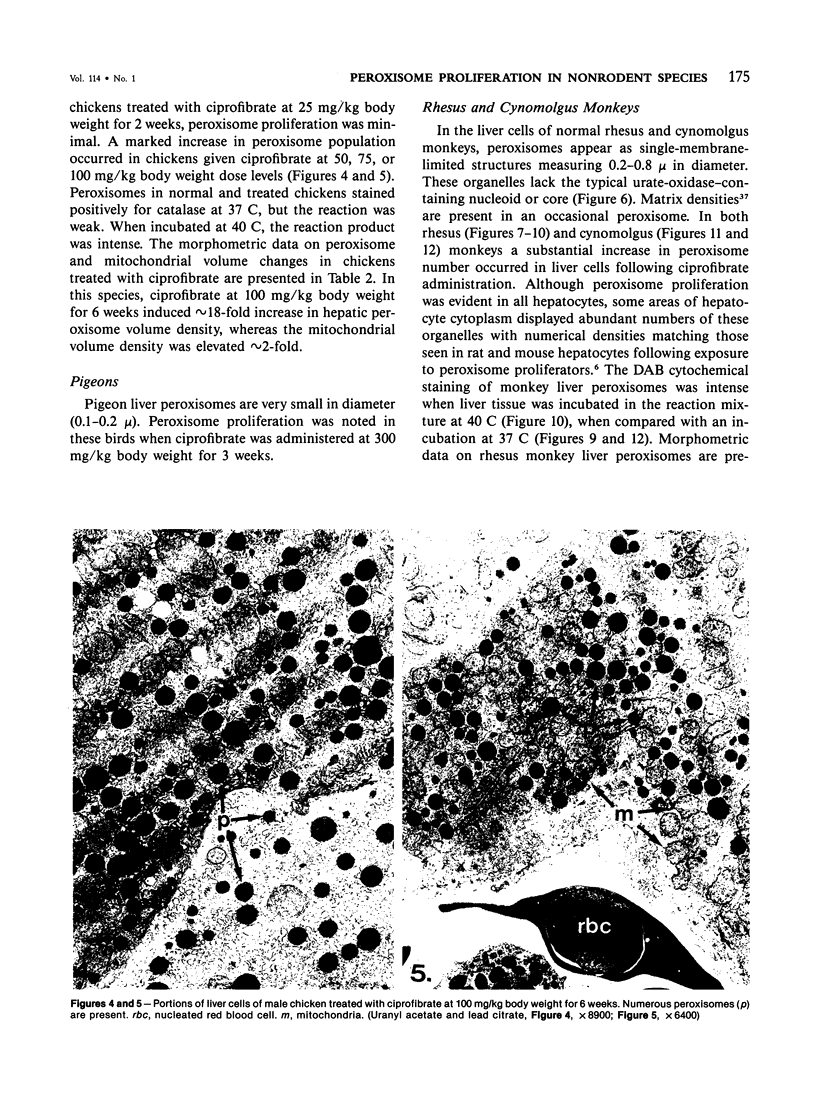
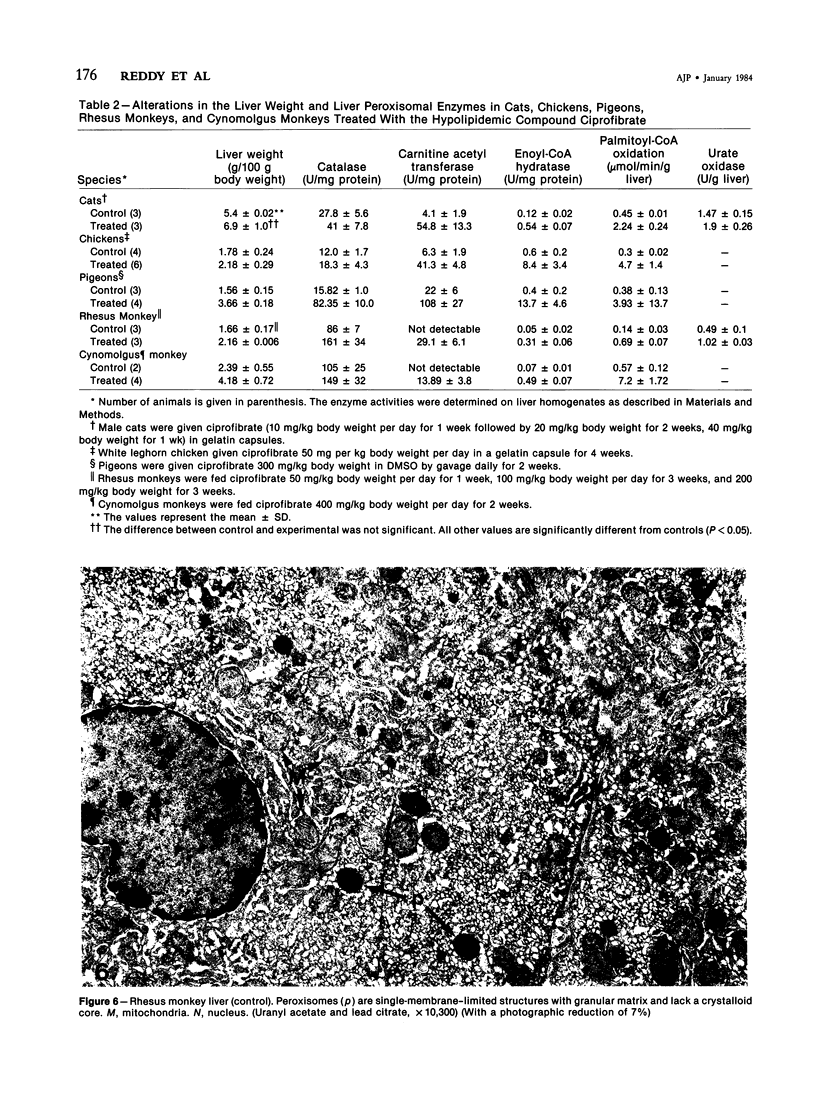

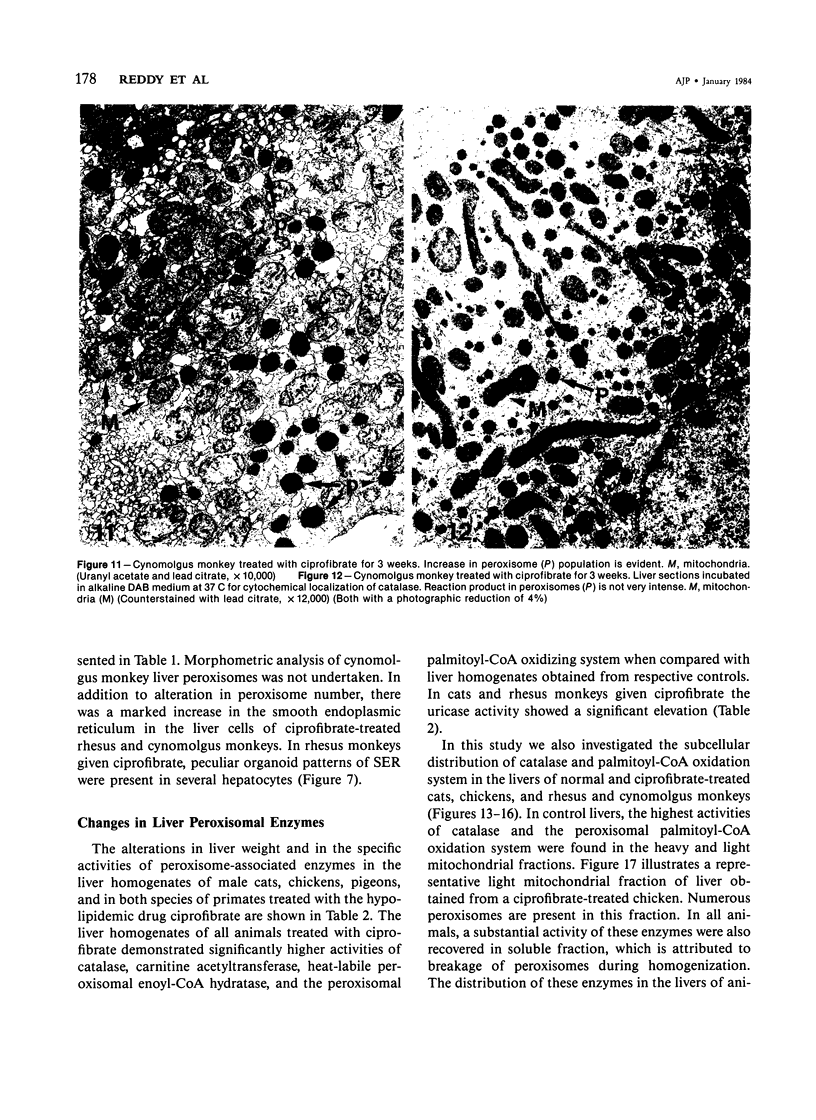
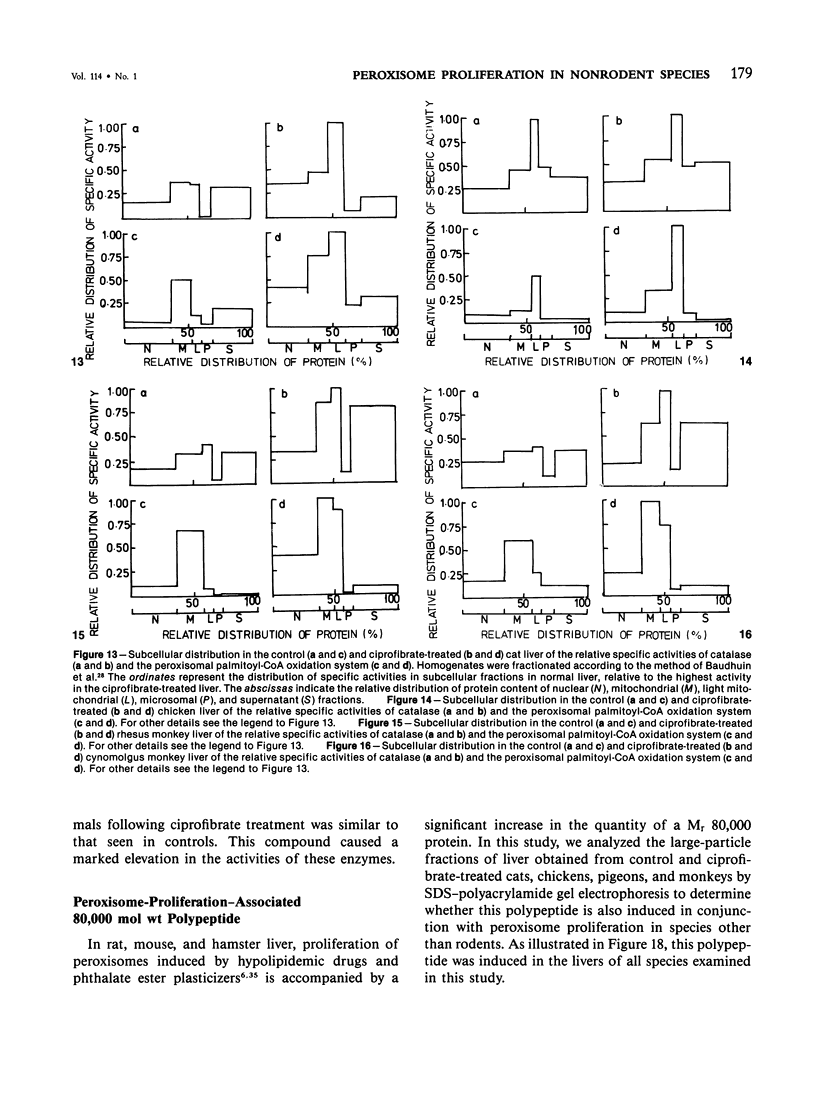
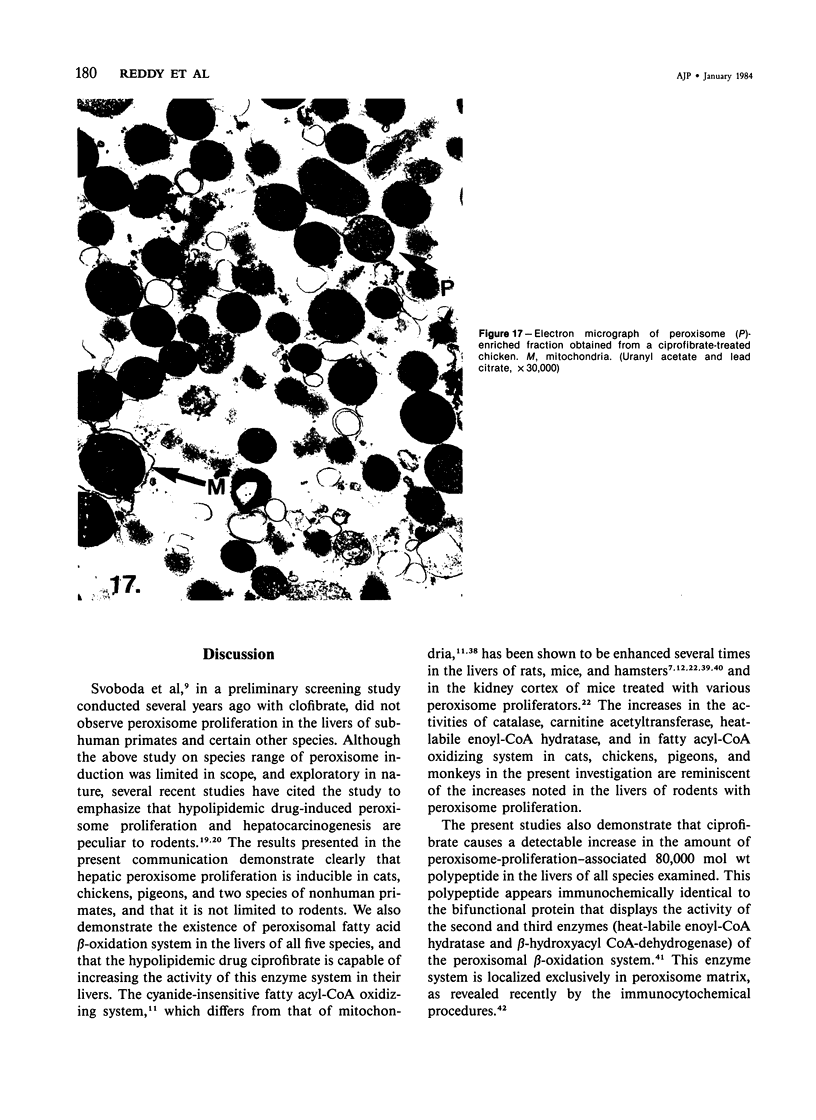
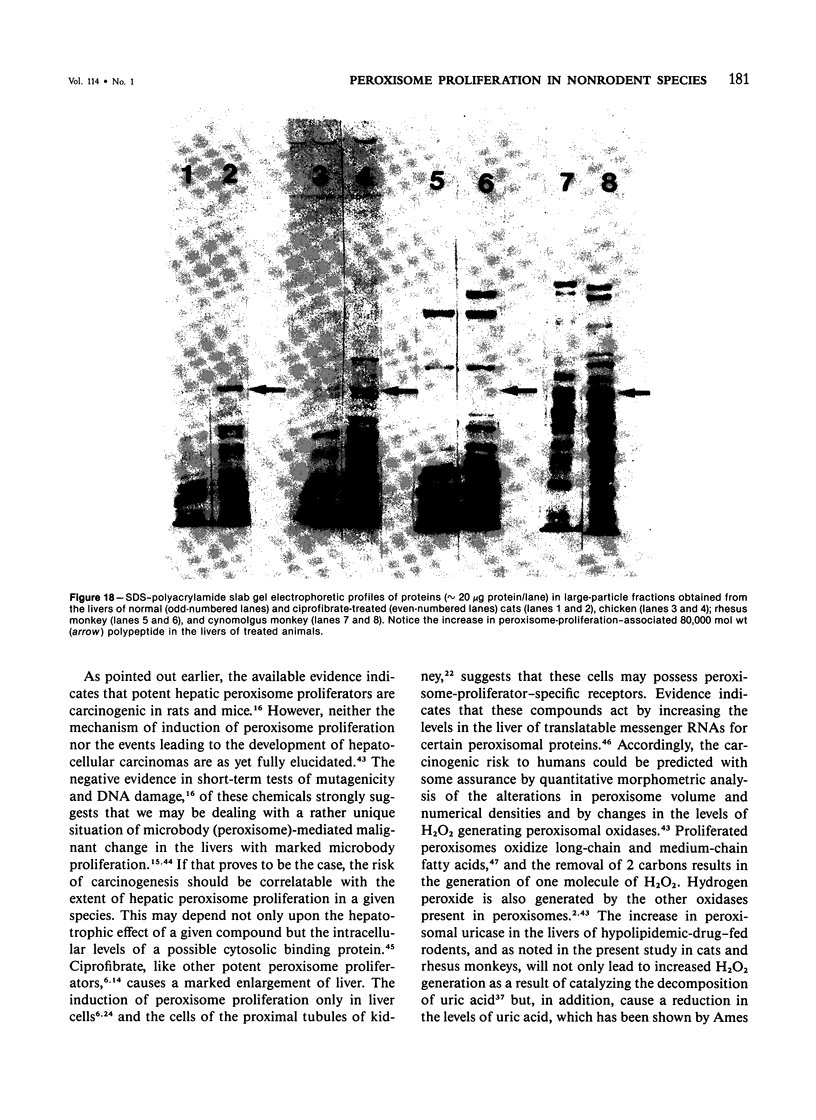


Images in this article
Selected References
These references are in PubMed. This may not be the complete list of references from this article.
- Ames B. N., Cathcart R., Schwiers E., Hochstein P. Uric acid provides an antioxidant defense in humans against oxidant- and radical-caused aging and cancer: a hypothesis. Proc Natl Acad Sci U S A. 1981 Nov;78(11):6858–6862. doi: 10.1073/pnas.78.11.6858. [DOI] [PMC free article] [PubMed] [Google Scholar]
- Ames B. N., Mccann J., Yamasaki E. Methods for detecting carcinogens and mutagens with the Salmonella/mammalian-microsome mutagenicity test. Mutat Res. 1975 Dec;31(6):347–364. doi: 10.1016/0165-1161(75)90046-1. [DOI] [PubMed] [Google Scholar]
- Arnold A., McAuliff J. P., Powers L. G., Phillips D. K., Beyler A. L. The results of animal studies with ciprofibrate, a new orally effective hypolipidemic drug. Atherosclerosis. 1979 Feb;32(2):155–163. doi: 10.1016/0021-9150(79)90080-7. [DOI] [PubMed] [Google Scholar]
- Baudhuin P., Beaufay H., Rahman-Li Y., Sellinger O. Z., Wattiaux R., Jacques P., De Duve C. Tissue fractionation studies. 17. Intracellular distribution of monoamine oxidase, aspartate aminotransferase, alanine aminotransferase, D-amino acid oxidase and catalase in rat-liver tissue. Biochem J. 1964 Jul;92(1):179–184. doi: 10.1042/bj0920179. [DOI] [PMC free article] [PubMed] [Google Scholar]
- Bendayan M., Reddy M. K., Hashimoto T., Reddy J. K. Immunocytochemical localization of fatty acid metabolizing heat-stable and heat-labile enoyl-coenzyme A (CoA) hydratases in liver and renal cortex. J Histochem Cytochem. 1983 Apr;31(4):509–516. doi: 10.1177/31.4.6338108. [DOI] [PubMed] [Google Scholar]
- Blümcke S., Schwartzkopff W., Lobeck H., Edmondson N. A., Prentice D. E., Blane G. F. Influence of fenofibrate on cellular and subcellular liver structure in hyperlipidemic patients. Atherosclerosis. 1983 Jan;46(1):105–116. doi: 10.1016/0021-9150(83)90169-7. [DOI] [PubMed] [Google Scholar]
- Chatterjee B., Demyan W. F., Lalwani N. D., Reddy J. K., Roy A. K. Reversible alteration of hepatic messenger RNA species for peroxisomal and non-peroxisomal proteins induced by the hypolipidaemic drug Wy-14,643. Biochem J. 1983 Sep 15;214(3):879–883. doi: 10.1042/bj2140879. [DOI] [PMC free article] [PubMed] [Google Scholar]
- Hanefeld M., Kemmer C., Kadner E. Relationship between morphological changes and lipid-lowering action of p-chlorphenoxyisobutyric acid (CPIB) on hepatic mitochondria and peroxisomes in man. Atherosclerosis. 1983 Feb;46(2):239–246. doi: 10.1016/0021-9150(83)90115-6. [DOI] [PubMed] [Google Scholar]
- Hashimoto T. Individual peroxisomal beta-oxidation enzymes. Ann N Y Acad Sci. 1982;386:5–12. doi: 10.1111/j.1749-6632.1982.tb21403.x. [DOI] [PubMed] [Google Scholar]
- Hayashi H., Hino S., Yamasaki F., Watanabe T., Suga T. Induction of peroxisomal enzymes in rat liver by the hypolipidemic agent LK-903. Biochem Pharmacol. 1981 Jul 1;30(13):1817–1822. doi: 10.1016/0006-2952(81)90016-2. [DOI] [PubMed] [Google Scholar]
- Hess R., Stäubli W., Riess W. Nature of the hepatomegalic effect produced by ethyl-chlorophenoxy-isobutyrate in the rat. Nature. 1965 Nov 27;208(5013):856–858. doi: 10.1038/208856a0. [DOI] [PubMed] [Google Scholar]
- LOWRY O. H., ROSEBROUGH N. J., FARR A. L., RANDALL R. J. Protein measurement with the Folin phenol reagent. J Biol Chem. 1951 Nov;193(1):265–275. [PubMed] [Google Scholar]
- Laemmli U. K. Cleavage of structural proteins during the assembly of the head of bacteriophage T4. Nature. 1970 Aug 15;227(5259):680–685. doi: 10.1038/227680a0. [DOI] [PubMed] [Google Scholar]
- Lalwani N. D., Reddy M. K., Mangkornkanok-Mark M., Reddy J. K. Induction, immunochemical identity and immunofluorescence localization of an 80 000-molecular-weight peroxisome-proliferation-associated polypeptide (polypeptide PPA-80) and peroxisomal enoyl-CoA hydratase of mouse liver and renal cortex. Biochem J. 1981 Jul 15;198(1):177–186. doi: 10.1042/bj1980177. [DOI] [PMC free article] [PubMed] [Google Scholar]
- Lalwani N. D., Reddy M. K., Qureshi S. A., Moehle C. M., Hayashi H., Reddy J. K. Noninhibitory effect of antioxidants ethoxyquin, 2(3)-tert-butyl-4-hydroxyanisole and 3,5-di-tert-butyl-4-hydroxytoluene on hepatic peroxisome proliferation and peroxisomal fatty acid beta-oxidation induced by a hypolipidemic agent in rats. Cancer Res. 1983 Apr;43(4):1680–1687. [PubMed] [Google Scholar]
- Lalwani N. D., Reddy M. K., Qureshi S. A., Sirtori C. R., Abiko Y., Reddy J. K. Evaluation of selected hypolipidemic agents for the induction of peroxisomal enzymes and peroxisome proliferation in the rat liver. Hum Toxicol. 1983 Jan;2(1):27–48. doi: 10.1177/096032718300200103. [DOI] [PubMed] [Google Scholar]
- Lazarow P. B. Assay of peroxisomal beta-oxidation of fatty acids. Methods Enzymol. 1981;72:315–319. doi: 10.1016/s0076-6879(81)72021-4. [DOI] [PubMed] [Google Scholar]
- Lazarow P. B., De Duve C. A fatty acyl-CoA oxidizing system in rat liver peroxisomes; enhancement by clofibrate, a hypolipidemic drug. Proc Natl Acad Sci U S A. 1976 Jun;73(6):2043–2046. doi: 10.1073/pnas.73.6.2043. [DOI] [PMC free article] [PubMed] [Google Scholar]
- Lazarow P. B. Three hypolipidemic drugs increase hepatic palmitoyl-coenzyme A oxidation in the rat. Science. 1977 Aug 5;197(4303):580–581. doi: 10.1126/science.195342. [DOI] [PubMed] [Google Scholar]
- Markwell M. A., McGroarty E. J., Bieber L. L., Tolbert N. E. The subcellular distribution of carnitine acyltransferases in mammalian liver and kidney. A new peroxisomal enzyme. J Biol Chem. 1973 May 25;248(10):3426–3432. [PubMed] [Google Scholar]
- Miller E. C. Some current perspectives on chemical carcinogenesis in humans and experimental animals: Presidential Address. Cancer Res. 1978 Jun;38(6):1479–1496. [PubMed] [Google Scholar]
- Novikoff A. B., Goldfischer S. Visualization of peroxisomes (microbodies) and mitochondria with diaminobenzidine. J Histochem Cytochem. 1969 Oct;17(10):675–680. doi: 10.1177/17.10.675. [DOI] [PubMed] [Google Scholar]
- Osmundsen H. Peroxisomal beta-oxidation of long fatty acids: effects of high fat diets. Ann N Y Acad Sci. 1982;386:13–29. doi: 10.1111/j.1749-6632.1982.tb21404.x. [DOI] [PubMed] [Google Scholar]
- Osumi T., Hashimoto T. Enhancement of fatty acyl-CoA oxidizing activity in rat liver peroxisomes by di-(i-ethylhexyl)phthalate. J Biochem. 1978 May;83(5):1361–1365. doi: 10.1093/oxfordjournals.jbchem.a132044. [DOI] [PubMed] [Google Scholar]
- Rao M. S., Reddy M. K., Reddy J. K., Scarpelli D. G. Response of chemically induced hepatocytelike cells in hamster pancreas to methyl clofenapate, a peroxisome proliferator. J Cell Biol. 1982 Oct;95(1):50–56. doi: 10.1083/jcb.95.1.50. [DOI] [PMC free article] [PubMed] [Google Scholar]
- Reddy J. K., Azarnoff D. L., Hignite C. E. Hypolipidaemic hepatic peroxisome proliferators form a novel class of chemical carcinogens. Nature. 1980 Jan 24;283(5745):397–398. doi: 10.1038/283397a0. [DOI] [PubMed] [Google Scholar]
- Reddy J. K., Krishnakantha T. P. Hepatic peroxisome proliferation: induction by two novel compounds structurally unrelated to clofibrate. Science. 1975 Nov 21;190(4216):787–789. doi: 10.1126/science.1198095. [DOI] [PubMed] [Google Scholar]
- Reddy J. K., Kumar N. S. The peroxisome proliferation-associated polypeptide in rat liver. Biochem Biophys Res Commun. 1977 Aug 8;77(3):824–829. doi: 10.1016/s0006-291x(77)80052-1. [DOI] [PubMed] [Google Scholar]
- Reddy J. K., Lalwani N. D., Reddy M. K., Qureshi S. A. Excessive accumulation of autofluorescent lipofuscin in the liver during hepatocarcinogenesis by methyl clofenapate and other hypolipidemic peroxisome proliferators. Cancer Res. 1982 Jan;42(1):259–266. [PubMed] [Google Scholar]
- Reddy J. K., Moody D. E., Azarnoff D. L., Rao M. S. Di-(2-ethylhexyl)phthalate: an industrial plasticizer induces hypolipidemia and enhances hepatic catalase and carnitine acetyltransferase activities in rat and mice. Life Sci. 1976 May 1;18(9):941–945. doi: 10.1016/0024-3205(76)90412-4. [DOI] [PubMed] [Google Scholar]
- Reddy J. K., Rao M. S., Azarnoff D. L., Sell S. Mitogenic and carcinogenic effects of a hypolipidemic peroxisome proliferator, [4-chloro-6-(2,3-xylidino)-2-pyrimidinylthio]acetic acid (Wy-14, 643), in rat and mouse liver. Cancer Res. 1979 Jan;39(1):152–161. [PubMed] [Google Scholar]
- Reddy J. K., Rao S., Moody D. E. Hepatocellular carcinomas in acatalasemic mice treated with nafenopin, a hypolipidemic peroxisome proliferator. Cancer Res. 1976 Apr;36(4):1211–1217. [PubMed] [Google Scholar]
- Reddy J. K., Warren J. R., Reddy M. K., Lalwani N. D. Hepatic and renal effects of peroxisome proliferators: biological implications. Ann N Y Acad Sci. 1982;386:81–110. doi: 10.1111/j.1749-6632.1982.tb21409.x. [DOI] [PubMed] [Google Scholar]
- Reddy J., Chiga M., Svoboda D. Stimulation of liver catalase synthesis in rats by ethyl-alpha-p-chlorophenoxyisobutyrate. Biochem Biophys Res Commun. 1971 Apr 16;43(2):318–324. doi: 10.1016/0006-291x(71)90755-8. [DOI] [PubMed] [Google Scholar]
- Reddy M. K., Lalwani N. D., Qureshi S. A., Reddy J. K. Induction of hamster hepatic peroxisomal beta-oxidation and peroxisome proliferation-associated 80000 mol. wt. polypeptide by hypolipidemic drugs. Hum Toxicol. 1982 Mar;1(2):135–147. doi: 10.1177/096032718200100205. [DOI] [PubMed] [Google Scholar]
- Reddy M. K., Qureshi S. A., Hollenberg P. F., Reddy J. K. Immunochemical identity of peroxisomal enoyl-CoA hydratase with the peroxisome-proliferation-associated 80,000 mol wt polypeptide in rat liver. J Cell Biol. 1981 Jun;89(3):406–417. doi: 10.1083/jcb.89.3.406. [DOI] [PMC free article] [PubMed] [Google Scholar]
- Roels F., Goldfischer S. Cytochemistry of human catalase. The demonstration of hepatic and renal peroxisomes by a high temperature procedure. J Histochem Cytochem. 1979 Nov;27(11):1471–1477. doi: 10.1177/27.11.92501. [DOI] [PubMed] [Google Scholar]
- Steinman H. M., Hill R. L. Bovine liver crotonase (enoyl coenzyme A hydratase). EC 4.2.1.17 L-3-hydroxyacyl-CoA hydrolyase. Methods Enzymol. 1975;35:136–151. doi: 10.1016/0076-6879(75)35149-5. [DOI] [PubMed] [Google Scholar]
- Svoboda D. J., Azarnoff D. L. Response of hepatic microbodies to a hypolipidemic agent, ethyl chlorophenoxyisobutyrate (CPIB). J Cell Biol. 1966 Aug;30(2):442–450. doi: 10.1083/jcb.30.2.442. [DOI] [PMC free article] [PubMed] [Google Scholar]
- Svoboda D., Grady H., Azarnoff D. Microbodies in experimentally altered cells. J Cell Biol. 1967 Oct;35(1):127–152. doi: 10.1083/jcb.35.1.127. [DOI] [PMC free article] [PubMed] [Google Scholar]
- Warren J. R., Simmon V. F., Reddy J. K. Properties of hypolipidemic peroxisome proliferators in the lymphocyte [3H]thymidine and Salmonella mutagenesis assays. Cancer Res. 1980 Jan;40(1):36–41. [PubMed] [Google Scholar]
- Weibel E. R. Stereological principles for morphometry in electron microscopic cytology. Int Rev Cytol. 1969;26:235–302. doi: 10.1016/s0074-7696(08)61637-x. [DOI] [PubMed] [Google Scholar]












